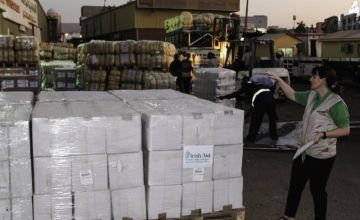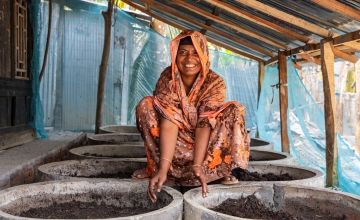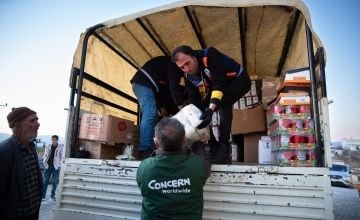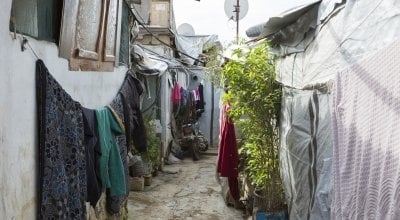
Read our 2023 annual report

Knowledge Hub
A common misconception is that refugees are flooding from Africa and Asia into Europe and North America. In most cases, they seek refuge in the closest neighbouring country.
In the past decade, the global refugee population has more than doubled. In 2022, we exceeded 30 million refugees. A common misconception, however, is where refugees flee. In most cases, people affected by the world’s largest refugee crises aren’t able to make it to high-income countries in Europe or North America. Instead, they take shelter in neighbouring countries—though the escalation of the humanitarian crisis in Ukraine in 2022 has changed things up a bit in terms of the ten countries that take in the most refugees.
Based on UNHCR data, here are those ten countries for 2024, as well as some of the challenges facing both refugees and host communities alike.
A quick note that we’re focusing specifically on refugees for this accounting. You can check out our explainer on the differences between migrants, refugees, asylum-seekers, and internally-displaced.
10. Ethiopia
Ethiopia is host to over 867,000 refugees. Most have escaped conflict in nearby South Sudan, Somalia, Sudan, and Eritrea. In recent years, COVID-19 has complicated the support of these refugee and internally-displaced communities, closing access to education for much of 2020 and creating shortages in medical supplies such as medications and diagnostic equipment. The country is also still recovering from the worst of the Horn of Africa crisis, a multi-year drought that continues to impact both refugee and host communities.

9. Sudan
While Sudan is one of the largest countries of asylum for refugees (over 926,000 as of mid-2023), it’s also the country of origin for one of the world’s largest refugee crises. It’s host to over 680,000 refugees from South Sudan — but even more Sudanese refugees have fled the country due to ongoing violence and instability. Because most refugees end up in a neighbouring country, this also means that there are over 295,000 Sudanese refugees currently hosted in South Sudan.
Concern is active in the area of Darfur, which is host to an overwhelming majority of people forcibly displaced from their homes, and working to support both refugees and host communities.
8. Bangladesh
Virtually all of the 961,000 refugees currently living in Bangladesh are stateless Rohingya, who began seeking asylum en masse in 2017 after violence broke out in Myanmar’s Rakhine State. In that time, the city of Cox’s Bazar has become home to the world’s largest refugee camp.
Bangladesh has also been hit especially hard by climate change, with increasingly severe weather patterns — especially in monsoon season. These risks are magnified among refugee communities, who live in informal housing that is routinely destroyed by flood and fire. The close quarters have also made the transmission of diseases like COVID-19 a major concern.
Concern has been responding to the Rohingya crisis since 2017. Together with UN agencies, over 130 local, national, and international nonprofits (including Concern) have supported the Government of Bangladesh to adjust to this increase in capacity. Safety and security remain serious concerns for the Rohingya living in Cox’s Bazar, especially in the wake of COVID-19.

7. Poland
Like Russia (see below), Poland became one of the countries to take in the most refugees owing to 2022’s escalation of conflict in Ukraine, with whom it shares a border. Over 989,000 refugees are currently in Poland, many from Ukraine. There are also several thousand refugees from Russia and Belarus.
6. Russia
In 2022, the Russian Federation became one of the world’s largest host communities and is currently hosting 1.24 million refugees. Nearly all of these refugees are from neighbouring Ukraine.

5. Uganda
Policymakers in Uganda have shaped and reshaped policy in recent years around providing safe and dignified shelter for an increasingly large refugee population that has grown from from 477,000 in 2015 to over 1.5 million in 2023. Over 882,000 are from South Sudan, and nearly half a million are from the Democratic Republic of Congo.
4. Pakistan
Pakistan is host to approximately 2.08 million refugees, almost entirely from Afghanistan (2,079,989). Many have lived in the country for decades, initially fleeing the decadelong Soviet-Afghan War. The country experienced a dramatic increase of Afghan refugees in 2001, many settling in the Balochistan province just across the border. The protracted nature of these displacements means that many refugee families have lived in compromised living circumstances for generations. Climate change and, more recently, COVID-19 have further complicated matters, as the coastal Balochistan province is prone to floods and pandemic-related border closures have affected communities and economies in both Pakistan and Afghanistan.
Concern has worked in Pakistan since 2001. Since then, we’ve developed long-term programmes in Balochistan, Punjab, and KPK province, each aimed at disaster risk reduction, financial security, and water and sanitation.
3. Germany
In recent years, out of the top countries that take in the most refugees, Germany was the only high-income country on the list. This changed in 2022 with the escalation of conflict in Ukraine, which has made large host communities out of Poland and Russia. It also made Germany the second-largest host community in the world, nearly doubling its refugee population in less than a year. At the beginning of 2022, Germany hosted 1.2 million refugees. As we enter 2024, the latest UNHCR data records 2.5 million. This includes over 1 million people from Ukraine, nearly 693,000 from Syria, 240,000 from Afghanistan, and over 150,000 from Iraq.

2. Türkiye
Over 3.36 million refugees are currently being hosted in Türkiye. The majority—3.33 million—are “Syrians under temporary protection.” Most Syrians in Türkiye live in host communities instead of informal tented communities, although many still live at bare-minimum conditions. Türkiye is also host to refugees from Iraq (over 12,000), Afghanistan (nearly 13,000), and Iran (over 5,300).
Concern is responding to immediate needs around cash and livelihoods, including participating in the world’s largest cash-grant programme (supported by EU funding). We’re also continuing to support communities affected by the deadly February 2023 earthquake in both Türkiye and Syria.
1. Iran
Iran experienced the largest growth in a refugee population on record in 2023, going from 840,000 refugees to over 3.4 million. With the exception of over 11,000 Iraqi refugees and a handful of asylum-seekers from Kuwait, Pakistan, and Uzbekistan, this is overwhelmingly due to an increase in refugees from neighbouring Afghanistan. Much of this, however, is due to how the country now classifies its refugees and an effort to legitimise previously-undocumented refugees. Approximately 2.6 million Afghans became documented refugees in the second half of 2022 following these measures.
Concern's work with refugees
Concern’s response to the world’s displacement crisis is in keeping with the Comprehensive Refugee Response Framework, approved by all 193 Member States of the United Nations in September, 2016.
The CRRF gives a set of guidelines for approaching the predictable aspects of these crises. This includes:
- Easing pressure on countries that welcome and host refugees
- Building self-reliance of refugees
- Expanding access to resettlement of refugees in third countries or offering other complementary pathways
- Fostering conditions that enable refugees to voluntarily return to their home countries
Last year alone, Concern responded to 76 emergencies in 23 countries, reaching 16.4 million people with urgent necessities such as shelter, psychosocial support, healthcare, and food as well as longer-term livelihood training that benefit both displaced and host communities.





